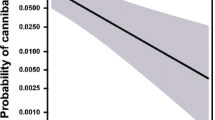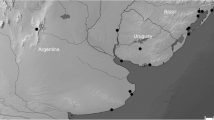Abstract
Secondary sexual traits are often assumed to increase reproductive success but can also carry costs for males bearing them. Here, we investigate potential foraging costs of foreleg ornamentation in wolf spiders in the genus Schizocosa. Given that the forelegs are involved in securing prey items and that ornaments may also inhibit general mobility, we hypothesized that the presence of ornamentation inhibits foraging success. To test this, we first took an ontogenetic approach. We conducted an experiment to examine variation in foraging behavior before and after ornament development in a population of Schizocosa that exhibits two male phentoypes: (a) brush-legged males that develop large brushes of hairs on their forelegs upon maturation and (b) non-ornamented males that lack ornamentation. When comparing penultimate versus mature foraging behavior between these two phenotypes, we predicted (i) reduced foraging intensity upon maturation for males of both groups (due to increased mate-searching behavior) and (ii) a greater decrease in foraging efficiency in brush-legged versus non-ornamented males (due to costs of ornamentation). As expected, we found that when exposed to prey, all males exhibited greater latencies to attack as matures than as penultimates, but unexpectedly, they differed in their patterns of attack frequency; brush-legged males decreased the number of attacks upon maturation while non-ornamented males increased. We found no support for our second prediction: neither male phenotype exhibited a change in foraging success upon maturation. Given that foraging behavior differed between ontogenetic stages, making it difficult to isolate the effects of ornamentation per se, we conducted a second experiment with a pure brush-legged population (S. ocreata) to directly test the influence of foreleg brushes on foraging behavior. We compared foraging behavior between mature males with brushes present versus mature males with brushes artificially removed and found no effect of the presence/absence of brushes on foraging success. In summary, using both ontogenetic and ornament manipulation approaches, we found no support for the hypothesis that ornamentation influences foraging success; however, we do document phenotype-dependent foraging behavior.



Similar content being viewed by others
References
Allen BJ, Levinton JS (2007) Costs of bearing a sexually selected ornamental weapon in a fiddler crab. Funct Ecol 21(1):154–161
Andersson M (1994) Sexual selection. Princeton University Press, Princeton
Badyaev AV, Ghalambor CK (1998) Does a trade-off exist between sexual ornamentation and ecological plasticity? Sexual dichromatism and occupied elevational range in finches. Oikos 82(2):319–324
Barbosa A, Moller AP (1999) Aerodynamic costs of long tails in male barn swallows hirundo rustica and the evolution of sexual size dimorphism. Behav Ecol 10(2):128–135
Basolo AL, Alcaraz G (2003) The turn of the sword: Length increases male swimming costs in swordtails. Proceedings of the Royal Society B-Biological Sciences 270(1524):1631–1636
Bern, M. (2011). Exploring sources of selection on the multimodal courtship displays of two sister species of wolf spiders: Schizocosa crassipalpata and Schizocosa bilineata. MS, University of Nebraska-Lincoln.
Clark CJ, Dudley R (2009) Flight costs of long, sexually selected tails in hummingbirds. Proceedings of the Royal Society B-Biological Sciences 276(1664):2109–2115
Fowler-Finn, K. (2009). Exploring the maintenance and selection on two distinct male morphs in a Schizocosa wolf spider. PhD, Univ. of Nebraska-Lincoln.
Fowler-Finn KD, Hebets EA (2011a) The degree of response to increased predation risk corresponds to male secondary sexual traits. Behav Ecol 22(2):268–275
Fowler-Finn KD, Hebets EA (2011b) More ornamented males exhibit increased predation risk and antipredatory escapes, but not greater mortality. Ethology 117(2):102–114
Fowler-Finn KD, Rosenthal M, Hebets EA (2013) Locomotor performace varies with adult phenotype in ornamented/non-ornamented wolf spiders. Ethology In press.
Framenau VW (2005) Gender specific differences in activity and home range reflect morphological dimorphism in wolf spiders (araneae, lycosidae). J Arachnol 33(2):334–346
Garcia CM, Jimenez G, Contreras B (1994) Correlational evidence of a sexually-selected handicap. Behav Ecol Sociobiol 35(4):253–259
Gibson JS, Uetz GW (2008) Seismic communication and mate choice in wolf spiders: Components of male seismic signals and mating success. Anim Behav 75:1253–1262
Grether GF (1997) Survival cost of an intrasexually selected ornament in a damselfly. Proc R Soc London, Ser B 264(1379):207–210
Grether GF, Grey RM (1996) Novel cost of a sexually selected trait in the rubyspot damselfly hetaerina americana: Conspicuousness to prey. Behav Ecol 7(4):465–473
Hallander H (1967) Range and movements of wolf spiders pardosa chelata (muller,of) and P pullata (clerck). Oikos 18(2):360
Hasselquist D, Bensch S (2008) Daily energy expenditure of singing great reed warblers Acrocephalus arundinaceus. J Avian Biol 39(4):384–388
Hebets EA, Stafstrom JA, Rodriguez RL, Wilgers DJ (2011) Enigmatic ornamentation eases male reliance on courtship performance for mating success. Anim Behav 81(5):963–972
Hebets EA, Vink CJ (2007) Experience leads to preference: Experienced females prefer brush-legged males in a population of syntopic wolf spiders. Behav Ecol 18(6):1010–1020
Matyjasiak P, Jablonski PG, Olejniczak I, Boniecki PI, Lee SD (1999) Foraging cost of a long tail ornament: An experiment with sand martin females. Ethology 105(6):521–530
Mayntz D, Toft S, Vollrath F (2009) Nutrient balance affects foraging behaviour of a trap-building predator. Biol Lett 5(6):735–738
Moller AP, Delope F (1994) Differential costs of a secondary sexual character—An experimental test of the handicap principle. Evolution 48(5):1676–1683
Moller AP, Delope F, Caballero JML (1995) Foraging costs of a tail ornament—Experimental-evidence from 2 populations of barn swallows hirundo-rustica with different degrees of sexual size dimorphism. Behav Ecol Sociobiol 37(5):289–295
Oufiero CE, Garland T (2007) Evaluating performance costs of sexually selected traits. Funct Ecol 21(4):676–689
Pruden AJ, Uetz GW (2004) Assessment of potential predation costs of male decoration and courtship display in wolf spiders using video digitization and playback. Journal of Insect Behavior 17(1):67–80
Ribak G, Swallow JG (2007) Free flight maneuvers of stalk-eyed flies: Do eye-stalks affect aerial turning behavior? Journal of Comparative Physiology a-Neuroethology Sensory Neural and Behavioral Physiology 193(10):1065–1079
Roberts JA, Taylor PW, Uetz GW (2007) Consequences of complex signaling: Predator detection of multimodal cues. Behav Ecol 18(1):236–240
Roberts JA, Uetz GW (2008) Discrimination of variation in a male signaling trait affects detection time in visual predators. Ethology 114(6):557–563
Rundus AS, Sullivan-Beckers L, Wilgers DJ, Hebets EA (2011) Females are choosier in the dark: Environment-dependent reliance on courtship components and its impact on fitness. Evolution 65(1):268–282
Scheffer SJ, Uetz GW, Stratton GE (1996) Sexual selection, male morphology, and the efficacy of courtship signalling in two wolf spiders (Araneae: Lycosidae). Behav Ecol Sociobiol 38(1):17–23
Shamble PS, Wilgers DJ, Swoboda KA, Hebets EA (2009) Courtship effort is a better predictor of mating success than ornamentation for male wolf spiders. Behav Ecol 20(6):1242–1251
Stafstrom JA, Hebets EA (2013) Female mate choice for multimodal courtship and the importance of the signaling background for selection on male ornamentation. Current Zoology 59:200–209
Stratton GE (2005) Evolution of ornamentation and courtship behavior in schizocosa: Insights from a phylogeny based on morphology (Araneae, Lycosidae). J Arachnol 33(2):347–376
Stratton GE, Uetz GW (1981) Acoustic communication and reproductive isolation in 2 species of wolf spiders. Science 214(4520):575–577
Stratton GE, Uetz GW (1986) The inheritance of courtship behavior and its role as a reproductive isolating mechanism in 2 species of schizocosa wolf spiders (Araneae, Lycosidae). Evolution 40(1):129–141
Swallow JG, Wilkinson GS, Marden JH (2000) Aerial performance of stalk-eyed flies that differ in eye span. Journal of Comparative Physiology B-Biochemical Systemic and Environmental Physiology 170(7):481–487
Toft S, Wise DH (1999) Growth, development, and survival of a generalist predator fed single- and mixed-species diets of different quality. Oecologia 119(2):191–197
Uetz GW, Dondale CD (1979) New wolf spider in the genus schizocosa (Araneae, Lycosidae) from Illinois. J Arachnol 7(1):86–88
Uetz GW, Papke R, Kilinc B (2002) Influence of feeding regime on body size, body condition and a male secondary sexual character in Schizocosa ocreata wolf spiders (Araneae, Lycosidae): Condition-dependence in a visual signaling trait. J Arachnol 30(3):461–469
Walther BA, Clayton DH (2005) Elaborate ornaments are costly to maintain: Evidence for high maintenance handicaps. Behav Ecol 16(1):89–95
Wilgers DJ, Hebets EA (2011) Complex courtship displays facilitate male reproductive success and plasticity in signaling across variable environments. Current Zoology 57(2):175–186
Wilgers DJ, Hebets EA (2012a) Age-related female mating decisions are condition dependent in wolf spiders. Behav Ecol Sociobiol 66(1):29–38
Wilgers DJ, Hebets EA (2012b) Seismic signaling is crucial for female mate choice in a multimodal signaling wolf spider. Ethology 118(4):387–397
Wilgers DJ, Nicholas AC, Reed DH, Stratton GE, Hebets EA (2009) Condition-dependent alternative mating tactics in a sexually cannibalistic wolf spider. Behav Ecol 20(4):891–900
Zahavi A (1975) Mate selection—a selection for a handicap. Theoretical Biology 53:205–214
Zuk M, Kolluru GR (1998) Exploitation of sexual signals by predators and parasitoids. Q Rev Biol 73(4):415–438
Acknowledgments
We thank Jenny Bushing, Amy Swoboda, Reed Stubbendieck, and Techla Schoenberger for assistance in spider care and maintenance; and Katie Heineman and Jason Stafstrom for aid in local collecting. We also thank Roger Santer for thoughtful comments and discussions on the study organism. We thank two anonymous reviewers for their beneficial feedback on this manuscript. Monetary assistance was provided by the UNL UCARE undergraduate research program to MFP and EAH; by the National Science Foundation (IOS – 0643179, to EAH), REU funding (IOS – 0934990, to EAH), DDIG funding (IOS-1010806, to EAH and KDFF); and by the UNL Population Biology Program of Excellence (to LSB). This research was conducted as part of an honors thesis at UNL by MFP.
Author information
Authors and Affiliations
Corresponding author
Rights and permissions
About this article
Cite this article
Pesek, M.F., Hebets, E.A., Sullivan-Beckers, L. et al. Foreleg Ornaments Do Not Hinder Foraging Success in Brush-Legged Wolf Spiders. J Insect Behav 26, 837–849 (2013). https://doi.org/10.1007/s10905-013-9398-0
Revised:
Accepted:
Published:
Issue Date:
DOI: https://doi.org/10.1007/s10905-013-9398-0




